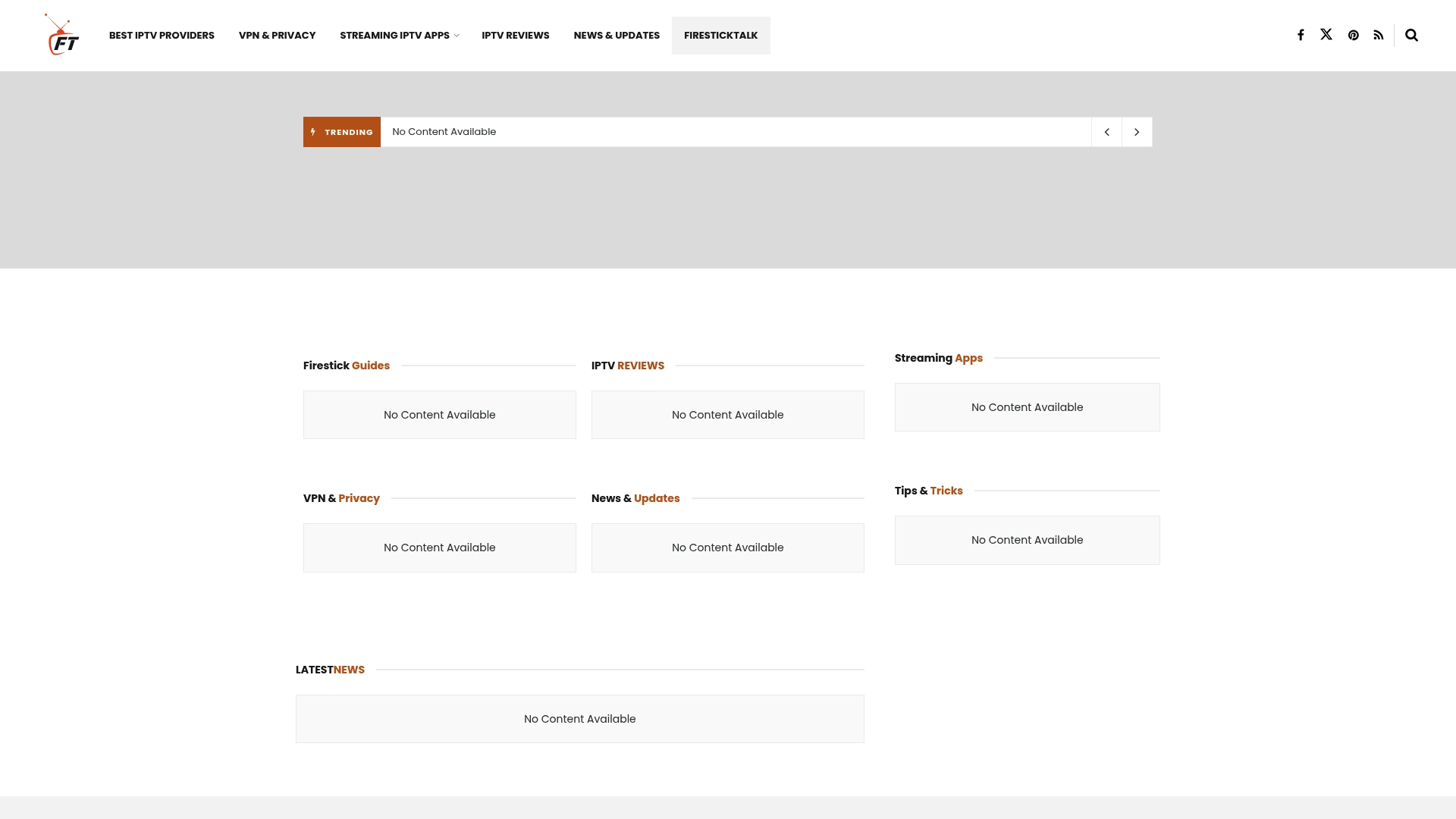IPTV is changing how people watch television, using the internet to deliver shows and movies instead of old-school cable. Most folks still picture flipping channels or waiting for favorite shows on a set schedule, but now over 100 million users worldwide are streaming exactly what they want, whenever they want. The biggest surprise? IPTV is not just about convenience, it is reshaping what viewers expect from TV—creating smarter, safer, and more personal experiences than ever before.
Table of Contents
- What Is Iptv And How Does It Work?
- The Importance Of Iptv Providers In Streaming
- Key Features And Services Offered By Iptv Providers
- Comparing Iptv Providers: Quality And Content
- Understanding Privacy And Security In Iptv Services
Quick Summary
| Takeaway | Explanation |
|---|---|
| IPTV uses internet for streaming | IPTV delivers television content via internet protocols, replacing traditional cable and satellite methods. |
| On-demand viewing enhances user control | Users can choose when to watch content, unlike traditional broadcasting, which is time-bound. |
| Content variety is a key differentiator | IPTV providers offer extensive and diverse content libraries, catering to various interests and preferences. |
| Robust security measures are essential | Users must consider digital threats and use tools like VPNs to protect their browsing and streaming activities. |
| Quality performance is critical for satisfaction | High resolution, minimal buffering, and device compatibility represent essential factors for a positive streaming experience. |
What is IPTV and How Does it Work?
IPTV, or Internet Protocol Television, represents a revolutionary approach to delivering television content through internet networks instead of traditional cable or satellite methods. Unlike conventional broadcasting, IPTV transforms how users consume media by leveraging internet infrastructure to stream television programming.
The Technical Foundation of IPTV
At its core, IPTV works by converting television signals into digital data packets transmitted over high-speed internet connections. Cisco’s Networking Research indicates that this digital transmission allows for more flexible and interactive viewing experiences compared to traditional broadcast technologies.
The process involves several key technical components:
- Content Encoding: Television signals are compressed and converted into digital formats
- Content Delivery: Digital packets are routed through internet networks
- User Reception: Special set-top boxes or compatible devices decode and display the content
Streaming Mechanisms and User Experience
Unlike traditional broadcasting that sends signals simultaneously to all viewers, IPTV provides on-demand streaming. This means users can select and watch content precisely when they want, giving unprecedented control over their viewing experience. TechRadar’s Streaming Analysis suggests that this model allows for more personalized content consumption.
IPTV typically offers three primary content delivery methods:
- Live Television: Real-time broadcasting of channels
- Time-Shifted Media: Rewatching recently aired programs
- Video-on-Demand: Accessing a library of pre-recorded content
The technological infrastructure behind IPTV enables viewers to enjoy high-quality, seamless streaming with minimal buffering, provided they have a robust internet connection. By transforming television into a more interactive and flexible medium, IPTV represents the future of media consumption in our increasingly digital world.
To help clarify how IPTV providers deliver content, here is a breakdown of the three main methods of IPTV content delivery and what each offers.
| Content Delivery Method | Description | Typical User Benefit |
|---|---|---|
| Live Television | Real-time broadcasting of channels | Enables users to watch events as they happen |
| Time-Shifted Media | Rewatching recently aired programs | Allows flexible viewing schedules |
| Video-on-Demand (VOD) | Library of pre-recorded content available anytime | Lets users choose what to watch, when |
The Importance of IPTV Providers in Streaming
IPTV providers play a critical role in transforming how users access and consume digital media, serving as the crucial infrastructure that enables seamless streaming experiences across various devices and platforms.
Content Aggregation and Distribution
IPTV providers are essentially the digital gatekeepers who curate and distribute multimedia content across internet networks. Statista’s Media Research highlights that global IPTV subscriber numbers continue to grow exponentially, underscoring the significance of these providers in modern entertainment ecosystems.
The key responsibilities of IPTV providers include:
- Content Licensing: Negotiating rights to stream television channels and media
- Technical Infrastructure: Maintaining robust servers and streaming platforms
- Quality Control: Ensuring consistent streaming performance and video quality
Technological Innovation and User Experience
Beyond simple content delivery, IPTV providers are driving technological innovation in streaming services. These platforms continuously evolve to offer more personalized, interactive, and sophisticated viewing experiences. Gartner’s Digital Media Report suggests that advanced IPTV providers are integrating artificial intelligence and machine learning to enhance content recommendation algorithms.
Advanced features that distinguish top IPTV providers include:
- Multi Device Compatibility: Streaming across smartphones, smart TVs, and tablets
- Customizable Channel Packages: Allowing users to select preferred content
- Advanced Parental Controls: Enabling safe viewing environments
By bridging technological capabilities with user preferences, IPTV providers are not just delivering content but reshaping how audiences interact with digital media. Their role extends beyond simple transmission, becoming integral architects of modern entertainment experiences.
Key Features and Services Offered by IPTV Providers
IPTV providers distinguish themselves through a comprehensive range of features designed to enhance user entertainment experiences, offering more than traditional television broadcasting platforms.
Comprehensive Content Selection
Modern IPTV providers offer an extensive array of content that goes far beyond conventional cable television. Nielsen’s Media Research indicates that users now expect diverse, personalized content libraries that cater to specific interests and preferences.
Typical content offerings include:
- International Channels: Programming from multiple countries and languages
- Specialized Genre Packages: Sports, movies, documentaries, and niche interest channels
- Premium On-Demand Libraries: Recent movies and exclusive series
Advanced Streaming Technologies
Beyond content, IPTV providers invest heavily in technological infrastructure to deliver superior streaming experiences. Akamai’s Streaming Performance Report highlights that top providers focus on minimizing latency and maximizing streaming quality.
Key technological features include:
- 4K and High Definition Streaming: Ultra-clear video quality
- Multiple Simultaneous Device Connections: Viewing across various screens
- Adaptive Bitrate Streaming: Automatic quality adjustment based on internet speed
IPTV providers are transforming digital entertainment by offering flexible, technologically advanced platforms that adapt to individual user needs. Their comprehensive approach goes beyond traditional broadcasting, creating personalized, interactive viewing experiences that reflect the dynamic nature of modern media consumption.
The following table summarizes common content and technology features offered by leading IPTV providers to help you identify which services can best meet your needs.
| Feature | Description |
|---|---|
| International Channels | Programming from multiple countries and in various languages |
| Specialized Genre Packages | Curated channels focused on sports, movies, documentaries, and more |
| Premium On-Demand Libraries | Access to recent movies and exclusive original series |
| 4K and High Definition Streaming | Ultra-clear picture quality with minimal latency |
| Multiple Simultaneous Device Connections | Ability to stream on multiple devices at once |
| Adaptive Bitrate Streaming | Automatic video quality adjustment based on internet speed |
Comparing IPTV Providers: Quality and Content
Navigating the complex landscape of IPTV providers requires understanding the nuanced differences in service quality, content offerings, and technological capabilities that distinguish top-tier platforms from average streaming services.
Content Diversity and Depth
The hallmark of exceptional IPTV providers lies in their ability to offer comprehensive and diverse content libraries. Streaming Media Magazine reports that leading providers differentiate themselves through strategic content curation and international programming selections.
Key content evaluation criteria include:
![]()
- Channel Variety: Total number of channels and genre diversity
- Language Options: Multilingual content offerings
- Regional Specificity: Localized programming and cultural content
Technical Performance Metrics
Beyond content, technical performance represents a critical factor in comparing IPTV providers. TechRadar’s Streaming Performance Analysis emphasizes that users prioritize streaming reliability, video quality, and minimal buffering.
Crucial technical performance indicators encompass:
- Streaming Resolution: Consistent 4K and HD capabilities
- Buffering Speed: Minimal interruption during playback
- Device Compatibility: Seamless integration across multiple platforms
Successful IPTV providers recognize that modern consumers demand more than just content transmission. They must deliver personalized, high-quality, technologically sophisticated streaming experiences that adapt to individual user preferences and technological ecosystems.

Understanding Privacy and Security in IPTV Services
Privacy and security represent critical considerations for users navigating the increasingly complex landscape of internet-based television streaming, where digital vulnerabilities can potentially expose personal information and viewing habits.
Digital Threat Landscape
IPTV services introduce unique security challenges that extend beyond traditional broadcasting platforms. US Cybersecurity and Infrastructure Security Agency highlights the potential risks associated with internet-connected streaming technologies, emphasizing the need for robust protective measures.
Key digital security risks include:
- Data Interception: Potential unauthorized access to streaming data
- Personal Information Exposure: Risk of compromising user account details
- Malware Distribution: Potential introduction of harmful software through streaming platforms
User Protection Strategies
Effective privacy protection in IPTV services requires a multi-layered approach that combines technological safeguards with user awareness. Proactive measures can significantly mitigate potential security vulnerabilities and protect personal digital ecosystems.
Recommended protection strategies encompass:
- Virtual Private Networks (VPNs): Encrypting internet connections
- Secure Authentication: Implementing two-factor verification
- Regular Software Updates: Maintaining current security patches
Successful navigation of IPTV security demands a comprehensive understanding of potential digital risks and a commitment to implementing robust protective technologies. Users must remain vigilant and proactive in safeguarding their digital streaming experiences.
Here is a comparison of key digital security risks associated with IPTV services alongside recommended protection strategies users should consider.
| Digital Security Risk | Description | Recommended Protection Strategy |
|---|---|---|
| Data Interception | Unauthorized access to streaming and personal data | Use a VPN |
| Personal Information Exposure | Potential compromise of account and identity details | Enable secure authentication |
| Malware Distribution | Introduction of harmful software via streaming platforms | Keep software updated |
Take Control of Your IPTV Experience With Expert Guidance
Do you ever feel overwhelmed when trying to compare IPTV providers or worry about privacy and security while streaming? From navigating technical jargon like adaptive bitrate streaming to finding reliable providers and protecting your data, it’s easy to feel uncertain about your next step. At FirestickTalk.com, we help you cut through the confusion and make informed choices. Discover easy-to-follow guides, honest IPTV service reviews, tips on streaming apps, and straightforward security advice—all designed for real Firestick users.

Don’t let uncertainty hold you back from a better entertainment experience. Explore our Uncategorized – Firestick Guides, IPTV Reviews & Streaming Apps page for the latest insights, or visit our homepage to get started. Now is the best time to take the guesswork out of streaming. Find your perfect IPTV solution today with the help of our trusted resources.
Frequently Asked Questions
What is IPTV and how does it work?
IPTV, or Internet Protocol Television, delivers television content through internet networks rather than traditional cable or satellite methods. It works by converting television signals into digital data packets, which are then streamed over high-speed internet connections.
What are the main features of IPTV services?
IPTV services typically provide live television, time-shifted media for rewatching programs, and video-on-demand access to a library of pre-recorded content. They also offer extensive content selection and various advanced features related to streaming technology.
How do I evaluate the quality of an IPTV provider?
To evaluate the quality of an IPTV provider, consider factors such as content diversity, channel variety, technical performance (including streaming resolution and buffering speed), and device compatibility. High-quality providers will offer a robust selection of channels and reliable streaming with minimal interruptions.
What security concerns should I be aware of when using IPTV services?
Users should be aware of potential risks such as data interception, personal information exposure, and malware distribution. To mitigate these risks, it’s recommended to use Virtual Private Networks (VPNs), implement secure authentication measures, and keep software updated with the latest security patches.


